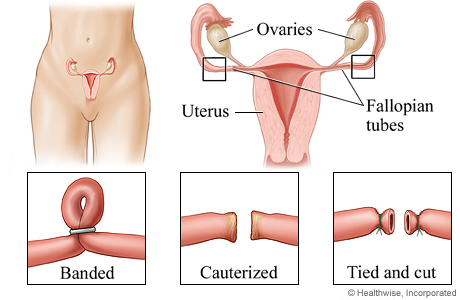If you’ve watched my videos on YouTube over the years you’re likely well versed with my support of safe sex practices. You know, the kind that leave you free of worries about an unintended pregnancy or possible transmission of an STD. As such, I hope this page gives you the insight you need to help find a method of protection that’s right for you.
 What is a Tubal Ligation?
What is a Tubal Ligation?
For those who have decided that they do not want more (or any) children, tubal Ligation, commonly referred to as “getting your tubes tied,” is a surgical sterilization technique that can be done at any time.
Before we go over what tubal ligation is, it’s important to understand how pregnancy occurs; every month the fallopian tubes carry an egg from one of your ovaries to the uterus. By blocking or removing the path egg takes through the fallopian tubes, the egg cannot travel to the uterus and be fertilized. If the egg doesn’t become fertilized by sperm, a pregnancy cannot occur.
In a tubal ligation, the fallopian tubes are cut, burned, or blocked with rings, bands, or clips (pictured right) with the intention of permanently blocking or removing the path the egg takes therefor stopping any chance of a pregnancy occuring.
 How is a Tubal Ligation Performed?
How is a Tubal Ligation Performed?
The procedure is an out-patient surgery done in a clinic, doctor’s office, or hospital which can be performed under local or general anesthesia.
There are 3 ways in which a Tubal Ligation may be performed
1.) As an outpatient procedure; a needle is inserted through the navel and the abdomen is inflated with gas (carbon dioxide or nitrous oxide). Then a laparoscope (a thin tube equipped with a camera lens and light, pictured left) is inserted into the abdominal cavity to help them see the pelvic organs. Using instruments passed through the abdominal wall, the doctor will seal the fallopian tubes by destroying segments of the tubes or blocking them with plastic rings or clips. If the laparoscope doesn’t contain a channel for passing instruments, the doctor may make a second incision above the pubic bone to insert special grasping forceps. After the procedure has been completed the gas will be withdrawn from the abdomen and the small incision will be sewn up. Patients may be allowed to go home several hours after the procedure or required to spend the night in the hospital depending on the health of the patient and any previously made arrangements.
2.) After child birth; If having a tubal ligation after vaginal childbirth is a more fitting option, the doctor will likely make a small incision under the navel, providing easy access to the still enlarged uterus and fallopian tubes. The health care provider then cuts and ties the fallopian tubes.
3.) During a C-section: with easy access to the area, the health care provider will cut and tie the fallopian tubes after the baby is delivered.
Generally the procedure takes about 30 minutes. In some cases, it is done immediately after a woman gives birth. If the procedure was done in combination with childbirth, the tubal ligation isn’t likely to prolong the patients hospital stay.
What can a patient expect after the procedure?
Whether or not the tubal ligation was performed in combination with childbirth, patients usually need to rest for at least a day after the procedure.
Common side effects may include:
- Abdominal pain or cramping
- Fatigue
- Dizziness
- Gassiness or bloating
- Shoulder pain
- Sore throat
It has been advised that patients avoid using aspirin for pain relief, since it may promote bleeding. Bathe 48 hours after the procedure is usually okay, , but avoid straining or rubbing the incision for one week. Carefully dry the incision after bathing making sure that it is clean and there is no discharge which could be a sign of infection. Also avoid strenuous lifting and sex for one week. Patients are advised to resume normal activities gradually as they begin to feel better. More often the health care provider will use stitches that will dissolve and won’t require removal. It’s also important to make an appointment to see your doctor a week after the procedure to make sure the body is healing properly.
What are the advantages?
- Female sterilization does not involve hormones.
- It is a permanent form of birth control.
- There are no changes in sexual desire, menstrual cycle, or ability to breastfeed.
- The procedure is usually a same-day procedure done in a surgical outpatient clinic.
- Immediately effective.
- Allows sexual spontaneity and requires no daily attention.
- Cost-effective in the long run.
What are the disadvantages?
- The procedure involves general or regional anesthesia.
- May not be reversible.
- It is meant to be a permanent form of birth control, and some women may regret the decision later.
- The two most common factors associated with regret are young age and unpredictable life events, such as change in marital status or death of a child.
- It can be expensive, ranging between $1,500 and $6,000
- Does not offer protection against STD’s, so a secondary method may need to be used.
How effective is Tubal Ligation?
A study taken from the The United States Collaborative Review of Sterilization has shown the cumulative 10-year failure rate with each method of tubal ligation as follows:
- spring clip method is 3.7%,
- electrocoagulation is 2.5%,
- interval partial salpingectomy (partial removal of tubes) is 2%,
- silicone rubber bands is 2%,
- postpartum salpingectomy (tubes cut after delivery) is 0.8%.
To learn more about each of the above methods of tubal ligation please speak with your health care provider.
Sit back, relax, let me come to you! Sign up below and have new posts sent straight to your inbox. Don’t worry, I promise not to spam you.
Return to the Permanent Contraception Methods Page





























